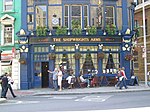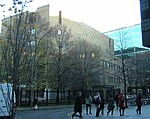Hay's Galleria
Grade II* listed buildings in the London Borough of SouthwarkGrade II listed buildings in the London Borough of SouthwarkLondon docksPrivately owned public spacesRedeveloped ports and waterfronts in London ... and 3 more
Retail buildings in LondonSt Martins Property GroupTourist attractions in the London Borough of Southwark

Hay's Galleria is a mixed use building in the London Borough of Southwark situated on the south bank of the River Thames featuring offices, restaurants, shops, and flats. Originally a warehouse and associated wharf (Hay's Wharf) for the port of London, it was redeveloped in the 1980s. It is a Grade II listed structure.
Excerpt from the Wikipedia article Hay's Galleria (License: CC BY-SA 3.0, Authors, Images).Hay's Galleria
Battle Bridge Lane, London Borough (London Borough of Southwark)
Geographical coordinates (GPS) Address Phone number Website External links Nearby Places Show on map
Geographical coordinates (GPS)
| Latitude | Longitude |
|---|---|
| N 51.5058 ° | E -0.0837 ° |
Address
Hay's Galleria
Battle Bridge Lane
SE1 2HD London, Borough (London Borough of Southwark)
England, United Kingdom
Open on Google Maps









